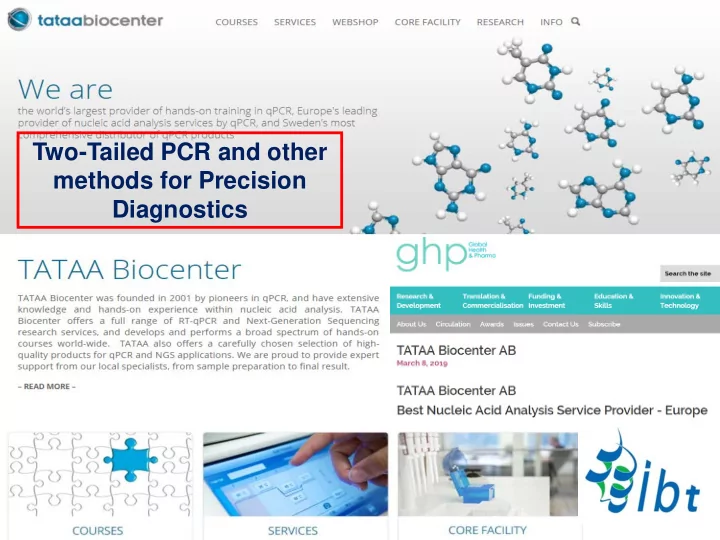

Two-Tailed PCR and other methods for Precision Diagnostics
Challenges analyzing miRNAs (and other short NA) • microRNAs are short (most 21-22 nt) and cannot fit two conventional PCR primers • There is no common sequence feature to use for the enrichment and amplification. • The mature miRNA sequence is present also in the pre- and the pri-miRNAs • miRNA isoforms (isomiRs) might evade capture, due to terminal heterogeneity
Current methods make the microRNA longer • Extension reduces sensitivity • One probe only limits specificity
Two-tailed RT-qPCR
Two-tailed RT-qPCR
Design concept
Design concept
Design concept
Sensitivity and dynamic range Sensitive to detect <10 molecules!
Sequence specificity across the entire microRNA
Benchmarking in biological samples
Discrimination of isomiRs
2-tube Multiplexing 8 different RT primers were pooled for multiplex reverse transcribed and subsequent singleplex qPCR Δ Cq (relative to singleplex protocol) Sample miR-122 miR-193a miR-1a miR-21a miR-24 miR-30c Let-7a brain -0.12 0.93 1.26 2.41 0.11 -0.08 0.72 cereb. 0.09 0.99 1.67 2.17 0.20 0.28 0.85 heart -0.21 0.67 1.38 2.06 -0.34 -0.13 0.50 kidney 0.32 0.95 1.90 2.26 -0.14 0.07 0.25 liver -0.20 0.85 1.73 2.50 -0.28 -0.20 0.44 lung 0.02 0.96 1.47 2.36 0.04 0.44 0.76 muscle -0.11 0.87 1.70 2.33 -0.17 -0.23 1.24 average -0.03 0.89 1.59 2.30 -0.08 0.02 0.68 st.dev. 0.19 0.11 0.22 0.15 0.20 0.25 0.32
1-tube Multiplexing 10 replicates Generic probe
1-tube Multiplexing 10 replicates Generic probe
www.spidia.eu
Quality control tool box for microRNA 5’-Phos for sequencing 40 < GC/% < 64 Endogenous controls mir-451a mir-23a
Test system for optimization • Human plasma (K 2 EDTA BD Vacutainer tubes; 1500g/3000g) • Human serum (8.5 ml, vacutainer SST II Advanced tubes) • Rat serum (1ml Eppendorf tube; 1000g/3000g) • Extraction: miRNeasy Serum/Plasma Advance kit (Qiagen) • RT: GrandScript FreePrime (TATAA) • qPCR: GrandMaster SYBR (TATAA)
Workflow Isolation spike-in mix RT spike-in mix Final concentration Final concentration RNA oligo RNA oligo (copies/μl) (copies/μl) 200x 40000x cel-miR-54 1.00E+07 cel-miR-76 1.00E+07 spike_A 2.00E+05 cel-miR-2 4.00E+03 200x spike_B 4.00E+03
Factors tested/optimized • Initial input volume used for RNA isolation. Risk for carry over of contaminants. Saturation of column. Most vendors recommend: 200 µ l. However, optimum volume seem to depend on: – isolation protocol – sample type – organism. • Hemolysis was prepared by addition of lysed erythrocytes (by freeze-thawing) in a serial dilution. Ratio mir-451a:mir-23a is tested as indicator for hemolysis – Mir-451a is highly abundant in erythrocytes – Mir-23a is abundant in serum/plasma, but not in erythrocytes • Effect of glycogen as carrier
Human plasma miRNeasy Serum/Plasma Advanced kit (Qiagen) Poor isolation Poor reproducibility reproducibility Poor yield Problems not due to RT or PCR inhibition
Human serum miRNeasy Serum/Plasma Advanced kit (Qiagen) Narrower optimal range
Rat serum miRNeasy Serum/Plasma Advanced kit (Qiagen) Lower optimal input volume
Conclusions Extracting with the miRNeasy Serum/Plasma Advanced kit (Qiagen) we find: • Relation between input sample volume and amount of cDNA is non-linear due to extraction issues. • Poor yields are observed with low as well as high input volumes. Working volumes are: – Human plasma: 250 µ l – Human serum: 300 – 500 µ l – Rat serum: 150 µ l
Effect of glycogen (human plasma) (15 g/l) Higher reproducibility: F-test, p<0.001) Higher yield: ∆ Cq=1.25, paired t-test, p<0.011)
Hemolysis Free oxyhemoglobin
mir-451a:mir-23a as indicator for hemolysis
Decision workflow Cel-miR-54-3p miR-spike-A miR-spike-B Cel-nir-76-3p Cel-miR-2-3p mir-451a mir-23a
Decision workflow Cel-miR-54-3p miR-spike-A miR-spike-B Cel-nir-76-3p Cel-miR-2-3p mir-451a mir-23a
https://www.biovendor.com/
Standard Material for absolute calibration https://webshop.tataa.com/product.html/validprime?category_id=27
Alu control assay for DNA contamination Mastermixes from three suppliers showing significant contamination of human gDNA when tested with Alu-assays. The Alu element is the most abundant sequence in the human Pos genome being present in over 1 million copies (11 %). TATAA Alu assays are supersensitive Neg for human genomic DNA. Clean Eppendorf tube left open in laboratory, being contaminated by DNA in the air Heat-labile dsDNA specific nuclease Particularly relevant for rare mutation detection https://webshop.tataa.com/product.html/tataa-alu-assay?category_id=66
Decision workflow www.cancer-id.eu Cel-miR-54-3p miR-spike-A miR-spike-B Cel-nir-76-3p Cel-miR-2-3p mir-451a mir-23a
∆ Amp Alu control assays for cellular DNA contamination ∆ Cq L/S = Cq L – Cq S = 0 cfDNA is gDNA fragmented ALuJB2 (S) 60 bp ALuYc1 (L) 187 bp cfDNA 160 bp ∆ Cq L/S = Cq L – Cq S >> 0 Trends in Genetics, June 2016, Vol. 32, No. 6
http://precisiondiagnostics.eu/ A SPIDIA Conference
Recommend
More recommend